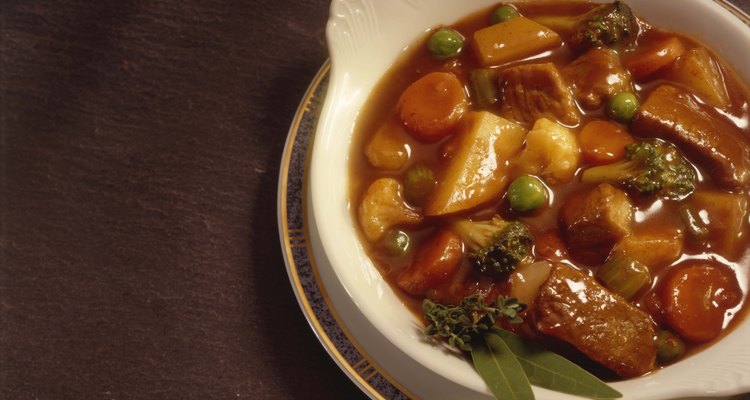
Coming home after a long day and scraping together a meal for the family is a challenge that almost every parent faces on a regular basis. Prepared foods are a convenient stopgap, but canned, frozen or microwaved meals aren't very inspiring as a steady diet. Slow cookers provide a better alternative, quietly simmering hot homemade meals all day while you're out. For example, a beef stew can spend up to 10 hours in your cooker, when prepared correctly.
Slow Cooking
Frugal home cooks have known for centuries that slow cooking could turn even the toughest, most indigestible meats or vegetables into savory and comforting foods. When an open fire was the primary cooking method, slow cooking took place in a heavy metal or earthenware pot nestled into the coals at the edge of the fire. Slow cookers recreate that gentle heat with a stoneware crock and a small electric element, safe enough to leave unattended through the day.
High vs. Low Cooking
Slow cookers invariably offer a high and a low setting, with more sophisticated models adding timers, automatic or programmable temperature control, or a keep-warm setting. Most dishes will cook in 2 to 4 hours at the high setting, or in 6 to 8 hours at the low setting. Beef stew can cook for 10 hours on the low setting of most slow cookers without its quality suffering. If your plans for the day require that long a cooking time, you'll need to make a few adjustments to the recipe.
Adjustments
The most important ingredient in your stew is the beef, so choose it wisely. For long cooking, your best bets are tough cuts such as chuck and shank, which have enough marbling and connective tissue to stay moist. Avoid lean cuts such as the round, which will dry out or disintegrate after a few hours. Cut the beef into larger pieces, up to 2 inches, rather than spoon-sized 1-inch cubes. "Waxy" potatoes such as Yukon Gold will hold their shape better than russets, and skin-on baby potatoes are even better. Cut vegetables such as carrots or parsnips slightly larger than you normally would, so they'll retain their texture for longer.
Cooking the Stew
Prepare the stew according to your favorite recipe, and fill the stoneware crock. Turn the cooker to its "Low" setting, and let it do its work. Don't lift the lid to check on your stew, if you happen to come home during the day. Letting out the accumulated heat can easily extend your cooking time an hour or more. When you get home at the end of the day, ladle out a cup or two of the cooking juices and whisk in a slurry of cold water and instant-mix flour. Return the mixture to your cooker for 15 to 20 minutes while you set the table, so the stew can thicken. Taste it and adjust the seasoning if necessary, then serve.
Related Articles

How to Use an Electric Roaster to Slow ...

Can You Slow-Cook Stew on the Stove Top?

How Long to Slow Cook Eye Round Roast ...

How Long Does It Take to Cook a ...
Does Slow Cooking Take Nutrients Out of ...

How to Cook Chicken in a Schlemmertopf ...

How to Slow Cook Country Ribs
Crock Pot Breakfast Casserole Recipe

How to Thicken Stew With Flour

How to Cook a Deer Brisket
Best Crock-Pot Lentil Soup Recipe

How to Cook a Boneless Turkey in the ...

How to Use a French Cooktop

How to Cook a Deer Neck Roast in a Slow ...

For How Long Do You Cook Hominy Posole?

How to Cook Silverside on a Stove Top

How to Steam Vegetables in an Electric ...

Cooking a Pot Roast in a Clay Pot

How to Cook Nathan Dinner Beef Franks

Can I Cook Chicken & Pork Together in a ...
References
- The Old World Kitchen: The Rich Tradition of European Peasant Cooking; Elizabeth Luard
- On Food and Cooking: The Science and Lore of the Kitchen; Harold McGee
- Crock-Pot.com: Harvest Beef Stew
Writer Bio
Fred Decker is a trained chef and certified food-safety trainer. Decker wrote for the Saint John, New Brunswick Telegraph-Journal, and has been published in Canada's Hospitality and Foodservice magazine. He's held positions selling computers, insurance and mutual funds, and was educated at Memorial University of Newfoundland and the Northern Alberta Institute of Technology.
Photo Credits
Jupiterimages/Comstock/Getty Images